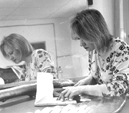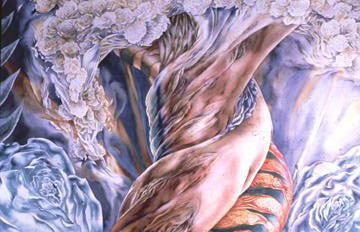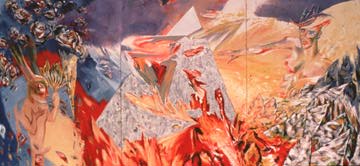Cynthia Kukla
Associate Professor
School of Art
College Of Fine Arts
Illinois State University
Normal, IL 61790-5620
Telephone: (309) 438-8074
Web: http://www.ilstu.edu/~cmkukla/
http://www.cfa.ilstu.edu/cmkukla/
Email: cmkukla@ilstu.edu
Paper: “Perceiving an Icon”
This paper addresses the theme of Impact 4 “in the context of the connections between history and the present” by way of examining classical images and classical working methods such as the Enlightenment embraced. In childhood I had the opportunity to see replicas of famous statues from antiquities in the collection from our neighbor’s former gift shop. The small replica of the Berlin Nefertiti stuck in my child’s mind as the most beautiful woman imaginable. In undergraduate art history; Egypt was skimmed over quickly to focus on the Renaissance and geographically favored areas – Europe – and masterpieces such as the Mona Lisa. I have been mining the exquisite territory of the Fertile Crescent long before the terrible events of September 11 and our newfound interest in this geographic region.
This panel’s focus on the enlightenment aesthetic provides for an opportunity to discuss the enlightenment’s particular faith in reason and observation. My goal is to make the connection between the photographic sources of Nefertiti that I have used in the past five years for a series of works on paper and the original source in Berlin. I expect to have different artwork resulting from having perceived and sketched this iconic masterpiece in person while I am in Berlin. I intend to compare the differences that result from using a double-mediated source (a photograph of a sculpture of an Egyptian queen) vs. a single-mediated source (perceiving the original sculpture.)
I will also question the current situation of how much we trust the mediated photographs we use as source material, photography long having eclipsed prints as sources of information. What happens when so many artists abdicate direct observation of a subject for the particular limits of the photographic print of said subject? In our postmodern era, the use of double-mediated sources is commonplace: Mark Tansy uses photographs of sculptures of pharaohs or emperors whereas Leon Golub, early in his career, studied objects from antiquity firsthand in Italy for his Gigantomachies and Sphinxes, sketching the subjects or ruins in person as Turner and others had done before the convenience of photography allowed us to remain comfortably in our studios. I wish to address our over-reliance on mediated sources and simulacra and that while we can rejoice in new worlds open to us through photography, satellite images of the firmament only imagined by our ancestors, bio-medical visualization that takes us into the microcosm and other imaging technology, that at the same time we should not, as artists, forgo the power of our direct observation of nature and culture when we create art.
 CYNTHIA KUKLA received her BFA from the School of the Art Institute of Chicago and MFA from the University of Wisconsin-Madison. She is a Professor of Art at Illinois State University where she has taught since 1993. Prior, she was tenured at Northern Kentucky University located outside Cincinnati, Ohio. She teachs painting, drawing, aqueous media, graduate seminars and the special topics "Contemporary Investigation of the Human Figure." This course resulted in distinguished exhibitions of student work in national juried printmaking exhibitions and in "Illinois Women Artists: the New Millenium," a two-year traveling exhibition sponsored by the National Museum of Women in the Ars, Washngton, D. C. Students begin coursework in "Contemporary Investigation of the Human Figure" by drawing directily from cadavers on paper or etching plates or in watercolors. They are the only art program that received special permission to use the cadaver lab at the University of Illinois-Chicago School of Medicine once the cadaver lab was closed at Illinois State. Etchings of observed cadavers in particular have been selected for exhibitions. In her studio work, Cynthia Kukla has exhibited in over fifty solo exhibitions at museums, art centers and galleries in the United States. She has participated in over 150 group exhibitions including the National Watercolor Society Annual Exhibition at the Laguna Beach Art Museum, California, the invitationals "Watercolor USA 1986: the Monumental Image" at the Springfield Art Museum, Missouri and the two-year traveling "Fact, Fiction and Fantasy: Recent Narrative Art in the Southeast" originating at the University of Tennessee, Knoxville. Her work has been seen on three continents. International invitational exhibits include: the Palace of Art and Vivarosi Gallery, Budapest, Hungary; Kharkov Art Museum, Ukraine; Fort Sztuki Association, Krakow and Fine Arts Academy of Warsaw, Poland; European Center for Arts and Letters, Nice, France and the American Embassy, Quito, Ecuador. In 2004, she was a keynote speaker for the exhibition "Coming of Age in Ancient Greece" at the Cincinnati Art Museum, Cincinnati, Ohio. She spoke on numerous panels and was panel chair for "The Role of Lost Art Techniques in the Postmodern Era for the 1989 College Art Association annual conference in San Francisco. She authors a website "Lost Art" (cfa.ilstu.edu/cmkukla) and is a Paul Harris Fellow of Rotary International.
CYNTHIA KUKLA received her BFA from the School of the Art Institute of Chicago and MFA from the University of Wisconsin-Madison. She is a Professor of Art at Illinois State University where she has taught since 1993. Prior, she was tenured at Northern Kentucky University located outside Cincinnati, Ohio. She teachs painting, drawing, aqueous media, graduate seminars and the special topics "Contemporary Investigation of the Human Figure." This course resulted in distinguished exhibitions of student work in national juried printmaking exhibitions and in "Illinois Women Artists: the New Millenium," a two-year traveling exhibition sponsored by the National Museum of Women in the Ars, Washngton, D. C. Students begin coursework in "Contemporary Investigation of the Human Figure" by drawing directily from cadavers on paper or etching plates or in watercolors. They are the only art program that received special permission to use the cadaver lab at the University of Illinois-Chicago School of Medicine once the cadaver lab was closed at Illinois State. Etchings of observed cadavers in particular have been selected for exhibitions. In her studio work, Cynthia Kukla has exhibited in over fifty solo exhibitions at museums, art centers and galleries in the United States. She has participated in over 150 group exhibitions including the National Watercolor Society Annual Exhibition at the Laguna Beach Art Museum, California, the invitationals "Watercolor USA 1986: the Monumental Image" at the Springfield Art Museum, Missouri and the two-year traveling "Fact, Fiction and Fantasy: Recent Narrative Art in the Southeast" originating at the University of Tennessee, Knoxville. Her work has been seen on three continents. International invitational exhibits include: the Palace of Art and Vivarosi Gallery, Budapest, Hungary; Kharkov Art Museum, Ukraine; Fort Sztuki Association, Krakow and Fine Arts Academy of Warsaw, Poland; European Center for Arts and Letters, Nice, France and the American Embassy, Quito, Ecuador. In 2004, she was a keynote speaker for the exhibition "Coming of Age in Ancient Greece" at the Cincinnati Art Museum, Cincinnati, Ohio. She spoke on numerous panels and was panel chair for "The Role of Lost Art Techniques in the Postmodern Era for the 1989 College Art Association annual conference in San Francisco. She authors a website "Lost Art" (cfa.ilstu.edu/cmkukla) and is a Paul Harris Fellow of Rotary International.

